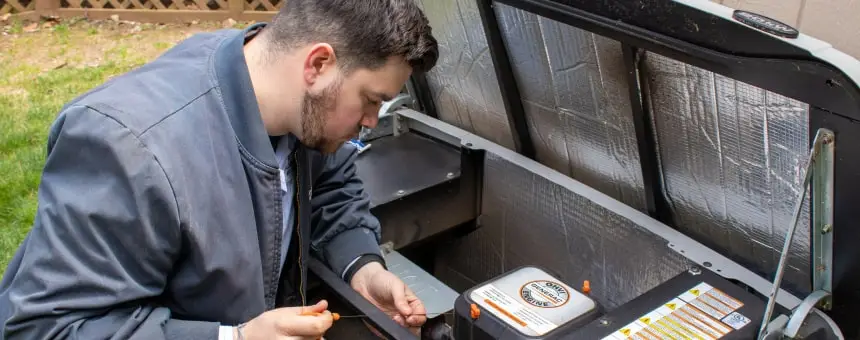Fireplaces can get a bad rap in the home improvement industry mostly because contractors say to batten them up simply because they are an energy loss risk. It’s true an unattended fireplace can leak air among a few other problems but is that enough to overlook the multitude of benefits that a unit could bring to your home? Bruni and Campisi urges you to think of some of the positives of having a fireplace before writing them off altogether:
- Extra source of warmth to cut down on heating bills
- Romantic, peaceful, and relaxing
- A backup heat and light source if the power goes out
- Adds value to your home to the right buyer
- A fun and unique place to cook
Of course, not all fireplaces offer these benefits which brings us to a question that homeowners often have to ask themselves. Which is the preferable fire source – gas or wood?
The Traditional Wood Burning Fireplace
When most people think of a fireplace, they conjure up images of the traditional wood logs crackling on an open flame. There’s not a whole lot to explain about a wood fireplace beyond that. The hearth is the brick and mortar of the fireplace that is encompassed by the surround. The surround contains the mantel which is the decorative aspect of the wood fireplace. From there you have the firebox, where the fire is contained, and the flue, where the smoke exits the home safely. The chimney is the protective unit surrounding the flue which also adds aesthetic value to the exterior of the house.
Wood burning fireplaces are considered a very inefficient heating source for one main reason. The flame needs oxygen and a draft to survive, but at the same time, you don’t want that draft forcing smoke and fire out into the home. Therefore the wood fireplace works in the opposite manner in that it sucks the air out of the home and up the flue in order to ‘stoke’ the fire. You’ll still get some warmth from the wood fireplace, but hopefully without all the smoke and ash that makes it look like your furniture and electronics were sitting by a campfire.
How Does a Gas Fireplace Differ?
There are a couple different types of gas fireplaces but in a nutshell, their biggest advantage as a whole is that they don’t produce smoke or ash. This might take some of the ‘fun’ out of owning a fireplace at your cabin, but the numerous advantages make up for this so-called ‘faux’-er place. First of all, the oxygen source for vented gas fireplaces comes from outside of the home meaning that all the heat can be placed into the home instead of dispelled out a chimney like a wood burning unit. The exhaust produced from burning the gas is vented out of the home in the same manner in which your clothes dryer works.
There are also ventless gas fireplaces that are very close to ‘plug and play’ units. These models work in the same manner as your gas stove range. The flame burns cleanly so it can be exposed to the open air (safety screens included) without any special venting being needed. You would think you’d have to have your stove cranked up to generate enough heat to warm a room, but gas fireplaces are manufactured in the opposite manner in that they require less fuel to create more heat. Thus ventless gas fireplaces are some of the most efficient heating sources on the market.
For those who don’t want to miss out on the ‘fun’ aspect of a wood burning fireplace flames, the closest alternative is gas logs which resemble that traditional wood hearth. The heat is available in an instant and you’ve got the cool piled-up wood aesthetics – without having to actually chop and replace the logs. Gas logs are available from Bruni in both vented and unvented systems.
Reiterating the Benefits of Gas Fireplaces Over Wood Burning Units
Wood fireplaces have the ‘look cool’ advantage over gas, few would argue that fact. Even so a wood fireplace is one of (if not THE) most efficient heating source available mostly because they cause the homeowner to force air out of the building in order to produce heat. Blocked flues and dampers can also present a huge safety risk, at the very least forcing smoke and ash back into your home and damaging costly electronics and furniture. These features need to be maintained on a very regular basis in order to avoid these problems. Plus, the chimney basically connects to the firebox through an actual hole in your house, making the whole unit an incredible leak threat that could damage drywall, flooring, wiring, insulation, and more.
Gas fireplaces provide a heat source without nearly any of the disadvantages of wood fireplaces. Gas fireplaces don’t require a chimney, merely small vents the size of the one you’d find on your dryer. Unvented gas fireplaces don’t even require that. There is no risk of a gas fireplace causing your roof to leak and there is no ash that emanates from the gas fireplace being in operation. You don’t even need to stoke a gas fireplace as most modern units operate via a remote or even an app on your smartphone.
Feel free to contact us to learn more about integrating a gas fireplace into your home. Once you start enjoying the benefits of these convenient units you’ll wish you called us Winters upon Winters ago.
Sources
https://www.houselogic.com/organize-maintain/home-maintenance-tips/ventless-fireplaces-what-you-need-know/
http://www.nytimes.com/2000/11/05/realestate/your-home-using-gas-fireplace-for-heat.htmlhttp://www.ventless-gas-fireplaces.com/frequently_asked_questions.html
http://www.hgtv.com/remodel/mechanical-systems/gas-fireplaces-offer-efficient-heating-choices
https://smarterhouse.org/heating-systems/types-heating-systems
http://heattalk.com/best-gas-fireplace-inserts-reviews/https://www.homeadvisor.com/r/vent-free-fireplaces/



MEMBERSHIPS
Bruni & Campisi offers a complete maintenance program for all your needs.
VIEW MEMBERSHIPS
